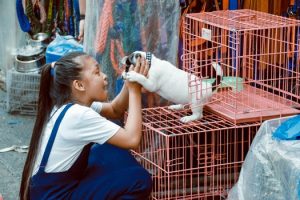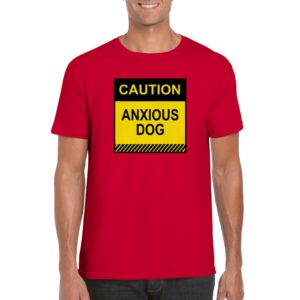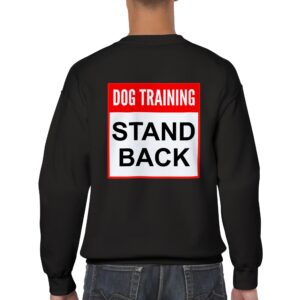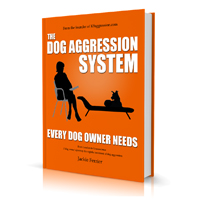Your cart is currently empty!
Why Dog Bites Happen More Often During Holidays [Infographic]

Dog bites are a very common occurrence during the holidays. One key reason is that everyone—including your dog—is stressed. Here are just some of the things you want to consider for the holidays.
Stress is a precursor to aggression
We all experience stress from time to time. A certain amount of stress (called Eustress) is actually good for us. Eustress is experienced when we encounter challenges that we believe we can solve. This can lead to increased satisfaction in life.
However, distress is a negative form of stress that most of us can’t avoid. We all need time to let our bodies and minds recover in order get back into a healthy balance.
However, too much stress without that recovery becomes chronic and can cause negative changes in the body and mind. These changes can lead to worsening mood and behavior when we don’t have down time to properly relax.

Dogs can detect many changes during and leading up to the holidays. Many of these changes can cause stress for dogs
- disruption of regular routines
- people around them behaving more stressed
- new people coming into the home
- different or unfamiliar interactions
- more noise, and often
- less exercise
We often fail to accurating interpret how dogs feel
It’s important to remember that all dogs have the potential to behave aggressively, just as all people do. Unfortunately dogs are unable to tell us what’s bothering them and humans often fail at understanding.
Stress can accumulate
The more often we and our dogs are exposed to unexpected situations or stress, the more likely that inappropriate behavior will occur (1). Stressed dogs are less tolerant dogs. Holidays can cause stress for dogs in many different ways.
Unfortunately, most people are not aware of just how stressed dogs can be or how stress can build up. One particular stressful situation may not be enough to cause problem, but the build up of it can. The accumulation of stress lead to disastrous consequences, even for the most mild-mannered dog. Almost all dog bites do not happen “out of the blue”.
Dog Aggression Risk Factors During the Holidays
Dogs Need More Space Than We Think
A big challenge is ensuring your dog gets the space away from people or other dogs when they need it. Having guests or additional people in the home can cause stress for your dog for a number of reasons.
Risk factor: Unwanted love
Whether you like animals or not, humans are hardwired to pay attention to them. (2) There is an evolutionary basis for this: we either needed to hunt, or we were prey. People who like (or love) animals often want to look at them, be close to them, touch them and it can be difficult for them to resist doing so making your dog may be a target for unwanted love.

While dogs can benefit from human interaction (3), like us, dogs can be particular to who, when and how they are touched.
Common physical interactions can be unpleasant to some dogs (4) and dogs are sensitive to subtleties around how it’s done (5).
Research also suggests how much contact is enjoyed depends on how familiar the dog is with the person (6).
Risk factor: Interacting with the dog incorrectly
Some people like to get dogs “wound up”, especially small dogs, finding their warning signs amusing. Other are uncomfortable showing more gentle signs of affection towards dogs. Some want to show they are not afraid of the dog or they are “alphas”. This can lead people to ruffle dog’s fur a little too roughly, or pat them more forcibly than dogs like.
Children may be too curious and poke, prod or pull instead of using gentle hands. Some just want to see what happens when they act with the dog in a particular way. Children in particular want to create some kind of reaction because this gives them a sense of power and control.
While your dog lovers are loving your dog, your dog might actually be saying no. In an era emphasising the importance of consensual touching of other people, we forget to do it with dogs. Teach others how to get consent from a dog to pet them and what everyone should know about petting dogs.
Risk factor: Physically moving your dog
We don’t like being pushed or pulled, and neither do dogs. And yet many people do this to get dogs off of furniture or out of the way. This is particularly common when we want to make room for guests, or trying to make room in a busy kitchen.
Instead teach your your dog touch your hand for a reward on cue. It’s easy to teach and an effective way to move them to where you want. Alternatively teach them to go to a resting spot and lie down. Otherwise, simply use a treat to lure the dog to where you want them to go.
Risk factor: Invasion of space
Invasion of space, on the other hand, can make many dogs unsettled. We like to think all that excitement at the door means the dog wants people to come in. Sometimes this is the case, but other times we misinterpret anxiety for excitement.
Dogs are naturally territorial and evolved to be connected to a relatively small number of others. USo unfamiliar people in the home can cause some dogs stress.
Space invasion may include:
- people coming too close too frequently
- people occupying their favourite resting spots
- children playing in their beds
- children putting fingers into bowls
If people ignore dogs’ warning signs, they may feel it’s necessary to growl or even bite.
In general guests should also avoid:
- dog’s dishes
- water bowls
- common resting areas
- toys
- excessive petting and attention unless the dog clearly enjoys it
Risk factor: Ignoring signs of stress in dogs
We assume that we know when our dogs are unhappy. When our dogs lose their appetite or the energy levels change, we know to take them to the vet. But the truth is we often miss the signs of stress and this can be one of the biggests reasons why bites happen more often during the holidays. Unless the signs are really obvious and in the case of dog biting, it’s usually too late.
Recognizing the more subtle communication telling us ur dogs are uncomfortable lowers the risk of dog bites.
Encourage your dog move away when you see the following signs:
- lip licking
- panting
- a turned head
- stiffened body posture
- lowered or “pinned back” ears
- head ducking (avoiding hands)
- stepping away (even if they are small steps)
When you know your dog is uncomfortable move them away. Don’t try to reassure your dog that the person is not a threat. You just need to calmly create space for your dog so your dog can relax.
Recognizing the signs of stress and responding appropriately is the first step in avoiding a confrontation.
Risk factor: Increased Distraction

Unfortunately during the holiday season we often have a lot of things competing for our attention such as:
- special food to make,
- gifts to wrap,
- homes to clean, tidy and decorate,
- people to visit with
- things to prepare,
In fact, we often find the holidays stressful because of all of the things we need to do. It’s hard to not become distracted by everything that needs to get done.
Regrettably, distraction is a risk. Even when you know the signs of stress in dogs, it requires us to pay attention to them. If we are not able to evaluate them properly we may miss the signs.
If you can, assign someone who knows how to read signs of stress to be the guardian of your dog. This will help you when you are otherwise occupied. Take turns with this person when your dog is “mingling” with your guests. Alternatively find your dog a safe resting area when you unable to pay full attention.
Risk factor: Emotional Challenges
In other cases, emotional challenges can cause us to turn inward and become distracted by our own inner turmoil. Certain holidays can be particularly difficult for people who:
- have suffered loss
- struggle in difficult relationships
- don’t have close social network they wish to have
- Find holidays stressful for one reason or another
Not only can inner turmoil cause is to be distracted, but dogs often pick up when things aren’t going right for us. This can cause them to worry.
Risk factor: Children

Young children under the age of nine are frequent targets of dog bites. Most children are bitten by a dog they know. Learn more with these seven facts on young victims of dog bites.
But it’s unfair to children to expect that they will follow your rules around your dog. No matter how well-behaved you or their guardians think they are, children will break rules.
By nature children are learning about the world and have a need to explore and experiment. But their abilities to assess risk and ability to empathize are not as well-developed as they are in an adult. Even the most well-behaved young person is likely to say what they know will please an adult. Most behave differently when no one is watching. Children’s brains are not fully developed. They cannot control their impulses like adults can. They are not able to clearly evaluate risk or risky behavior.
Good with some children does not mean good with all
While some dogs are less threatened by children because they are smaller, some dogs may be more stressed by children. Children can be unpredictable. The also sound and move differently. Never assume that is your dog is good with one child. Never assume your own children will be good with other dogs. Dogs discriminate more than humans. This means each situation is a brand new situation. Not all the things they have learned in one situation will carry over to the next.
Teach older children:
- How to tell if your dog wants to be petted
- How to watch for the signs of stress in your dog.
Kids love to be “dog-detectives”. Teaching them how is a great way to get them involved in a safer way with your dog.
If you have young children around your dog, be very careful to monitor their behavior and your dog’s comfort level. Have a plan if your dog to create space for your dog if he or she starts to become uncomfortable. Be aware that toddlers in particular can seem very threatening to some dogs.
The safest way to deal with children is to make sure your dog’s social, physical and mental needs are met before the party starts. Then put the dog in a comfortable room away from the children. Let them enjoy a food toy and a nap instead.
Risk factor: Multiple Dogs
If you have more than one dog, there may be additional dynamics to consider. The dogs may be less tolerant with one another than usual over the holiday season. They may want to compete for people’s attention, treats, even resting places. If there has ever been any tension between the dogs, you may see more of it now. This is particularly the case if you have one dog that is anxious, aggressive or aging. Dogs are inherently social and therefore are sensitive to tensions. An abnormally behaving dog will cause stress for other dogs even if the behavior is not direct.
Risk factor: Change in routine
Dogs thrive on routine even more than we do. When routines change, dogs are no longer able to predict what will happen next. A dog that doesn’t get his usual 7:30 breakfast has no way of knowing when he will be fed next. They don’t know how long he will have to ensure feeling hungry or have any way of lessening the hunger. Same with needing to go out to relieve themselves or a walk they look forward to alleviate boredom.
So while we might enjoy a change in routine, we are usually in control of it. The change in routine might cause stress and potentially lead to aggression for your dog. (7)
Three states to keep your eye on
Here are three states your dog might be experiencing over the holidays. These states can increase stress, and therefore increase the risk of aggression that you need to be conscious of:
- boredom
- frustration
- Worry or anxiety or concern over the unknown
A loss of control which makes coping with stress more difficult

Risk factor: Change in environment.
A change in environment can add stress in dog’s lives for the same reasons a change in routine can. But the inability to predict what will happen next may not be the only stressors. Their senses may also become overwhelmed. Here are some just a few things to consider:
- A christmas tree, air freshener or scents in the air or on furniture can overwhelming to a dog’s sense of smell.
- A dog that has been spending the majority of its days in a quiet home while everyone is at work or school might become overwhelmed with a house full of noise
- A dog uncomfortable with strangers or children may have to deal with the stress of how to deal with them.
- Eating new food (or garbage) can cause them to feel unwell.
Planning Ahead to Avoid Dog Growling and Bites
Planning a head of time can go a long way towards keeping things running smoothly.
Allow your dog to have a break away from guests (or even others in the home) and have a quiet place to chew on a food-stuff kong. In fact, starting a routine to include this before the holiday season starts is a good idea.
Plan how you will communicate to guests about how they should or should not touch your dog. Give children boundaries and activities they can do to interact with your dog safely. For example, some dogs might not like to be petted, but might not mind a child reading them a book. Teaching a child how to ask your dog to sit for a treat is a wonderful way for a child to interact assuming that your dog is comfortable being in the proximity of children.
Try to keep your schedules and routines as close to what they usually are as much as possible. Dogs become stressed when they can’t predict what will happen.
If you can, try to exercise your dog just a little more. Exercise is often one of the first things to go during the busy season. Aerobic exercise can be helpful in combating some of the stress. For both of you! In addition, dogs can really enjoy getting out of the house to explore the worlds with their noses. Let them engage in plenty of sniffing during walks.
Below, there are some common signs to look out for that indicate your dog is getting stressed. It is not a comprehensive list, but you can teach the children in your home to be “dog-detectives” and look out for some of these signs of stress and be sure to let you know. When you see the signs, it’s time to move your dog to a place where your dog can be more relaxed.
Teach your dog how to touch your hand, go to a mat and lie down for a reward now so you can easily move your dog without physically handling them.
Teach others in your home how to tell if your dog wants to be petted.
Please share to keep people and dogs safe!
Bites happen more often during holidays

References
(1) Overall, K (2013) Manual of Clinical Behavioral Medicine for Dogs and Cats, Karen Overall, Mosby (and Imprint of Elevier) Retrieved from https://books.google.ca/books?hl=en&lr=&id=HHoK9PKpqn4C&oi=fnd&pg=PP1&dq=karen+overall+dog+stress&ots=7u4mxSuKWn&sig=uIezw8NMURnbeevABGSI6Tinws4#v=onepage&q=stress&f=false
(3) Crista L. Coppola, Temple Grandin, R. Mark Enns, Human interaction and cortisol: Can human contact reduce stress for shelter dogs?, Physiology & Behavior, Volume 87, Issue 3, 30 March 2006, Pages 537-541, ISSN 0031-9384, http://dx.doi.org/10.1016/j.physbeh.2005.12.001.
(http://www.sciencedirect.com/science/article/pii/S0031938405005433)
(5) Michael B Hennessy, Michael T. Williams, Deborah D Miller, Chet W Douglas, Victoria L Voith, Influence of male and female petters on plasma cortisol and behaviour: can human interaction reduce the stress of dogs in a public animal shelter?, Applied Animal Behaviour Science, Volume 61, Issue 1, 14 December 1998, Pages 63-77, ISSN 0168-1591, http://dx.doi.org/10.1016/S0168-1591(98)00179-8.(http://www.sciencedirect.com/science/article/pii/S0168159198001798)
ADVERTISEMENT
The Dog Aggression System Every Dog Owner Needs E-book

Anxious Dog Shirts only available in our shop

Keep people away with our Stand back shirts

